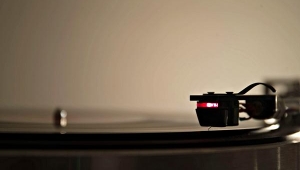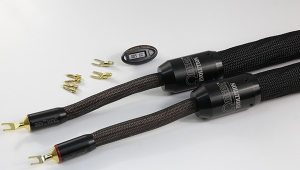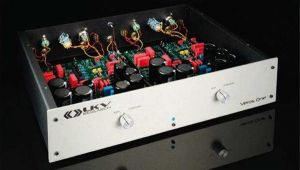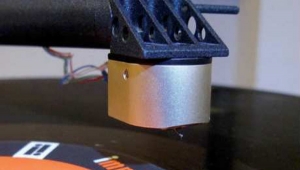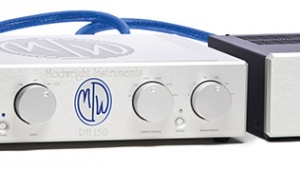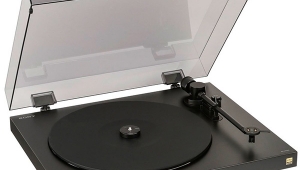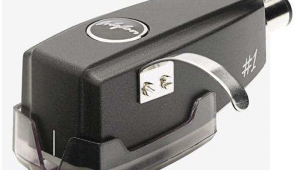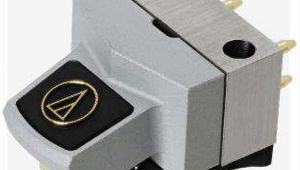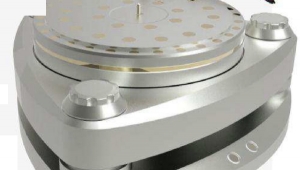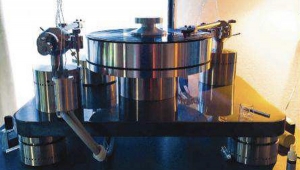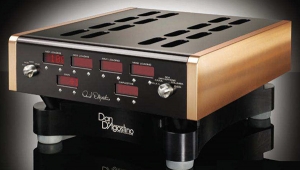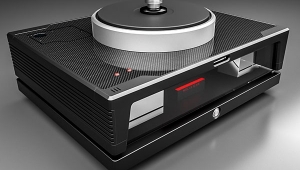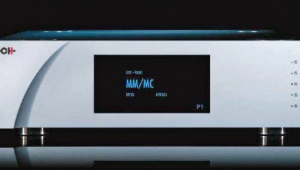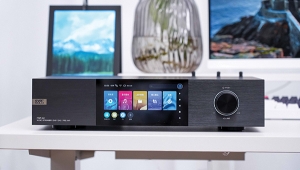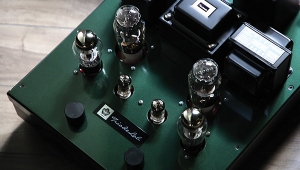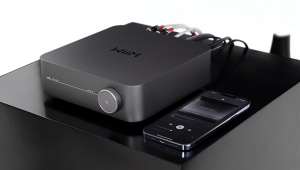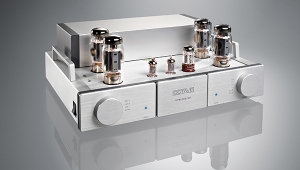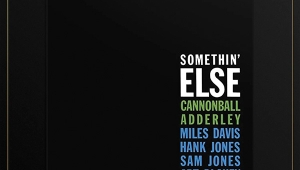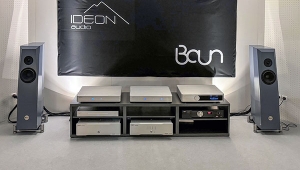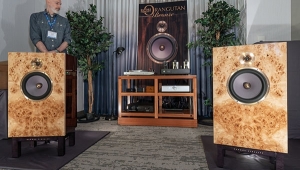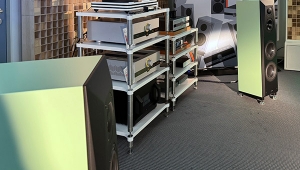| Columns Retired Columns & Blogs |
Analog Corner #248: Mørch DP-8, Reed 3P tonearms, TechDAS Air Force One turntable
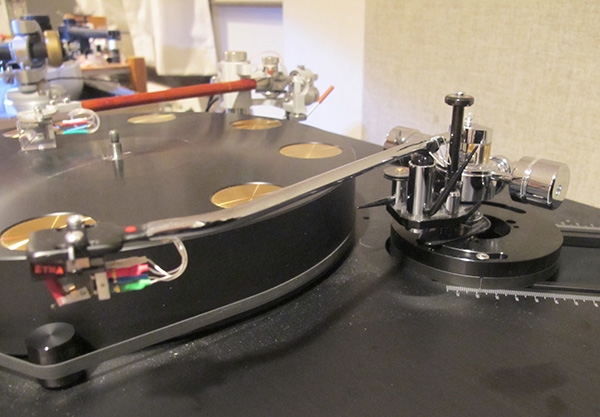
"HOW MEASUREMENT FAILS DOCTORS AND TEACHERS" was the headline of a story in a recent issue of the New York Times's "Sunday Review" section (formerly called "News of the Week in Review," now rendered obsolete by the 24/7 news cycle created by and for the terminally self-absorbed). The writer, Robert M. Wachter, a professor and interim chairman of UC San Francisco's department of medicine and author of the book The Digital Doctor: Hope, Hype, and Harm at the Dawn of Medicine's Computer Age, said that healthcare and education "have become increasingly subjected to metrics and measurements," and that the focus on them has "gone too far." (footnote 1)
Footnote 1: See New York Times, January 16, 2016.
To me, that headline screamed "Audio!" And the book that needs to be written is The Digital Recording Revolution: Hope, Hype, and Harm at the Dawn of Audio's Computer Age.
In the early 1980s, after hearing a CD at the format's US debut at an Audio Engineering Society convention in Los Angeles, I wrote a commentary for Music Connection Magazine (footnote 2). In it, I made the point that "compact discs are not the future. They don't sound better than records, and soon very few people will still have CD Players." Only the "soon" was wrong!
Recently, a troll who's fixated on me actually e-mailed to say, "Your problem is that you listen." Instead, he said, I should better educate myself in audio engineering. That way, he was certain, I'd stop advocating for vinyl, because my advocacy, which is based on listening, is ill-informed and therefore invalid.
At the January 2016 Consumer Electronics Show, during Meridian Audio's before-and-after demonstration of MQA audio-encoding technology, Bob Stuart first played a 24/96k transfer of Keith Jarrett's solo-piano The Köln Concert, and then the same recording processed with MQA, in which, he said, the time-domain sins of the original analog-to-digital converter—sins that I imagine were "unmeasurable" or "unmeasured"—had been corrected. The result was a dramatic improvement in imaging, soundstaging, and piano harmonics. No longer were the piano's attack, sustain, and decay confused with one another. No longer were the hall acoustics commingled with the sound of the piano.
Why, it sounded closer to the original LPs!
Back in the day, whenever I complained about CD's miserable imaging and soundstaging compared to vinyl, the stock response was that "all of that so-called imaging and soundstaging you're hearing on your records are really L–R artifacts." My answer to that was always: "Fine—if distortion makes it sound more real, I'll take the distortion." But as the MQA demo proved, the LP wasn't distorted—the CD was!
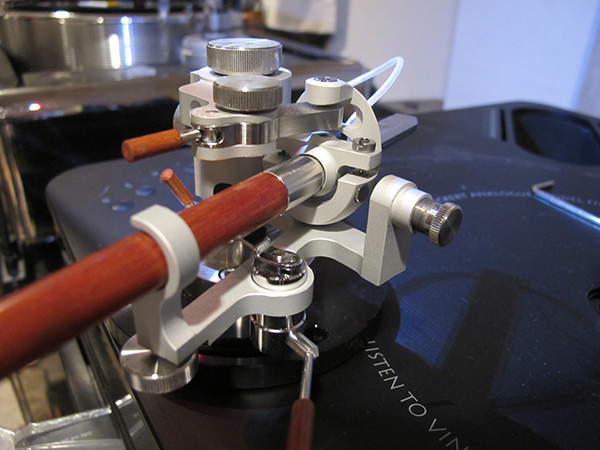
The Reed 3P's unique bearing system
Not Measured but Heard: the Reed 3P tonearm
Manufactured to a very high standard of fit'n'finish and presented—with equal attention to detail—in an attractive wooden box, the Reed 3P tonearm, made in Lithuania, is an elegantly machined tour de force that incorporates new and previously used tonearm ideas in a compact package that's relatively easy to set up and use.
Reed offers the 3P in 9.5", 10.5", and 12" versions; I chose to review the 9.5" version, which has an effective length of 240mm and an overhang of 17mm, because now I'm firmly in the camp of less is more when it comes to tonearm length—at least as between 9" and 12" arms. Yes, a shorter arm's tracking error is greater, and there's more skating side force, but—all else being equal—the shorter arm's lower mass should result in better dynamic behavior during record play. With a 1m phono cable of copper wire terminated with WBT RCA plugs, the 9.5" 3P sells for $5000 (footnote 3).
The 3P's armtube is available in a variety of woods, including Brazilwood (Caesalpinia echinata, aka Pernambuco), wenge (Millettia laurentii), ziricote (Cordia dodecandra), and western red cedar (Thuja plicata). While each has different but equally fine-looking cosmetics, Reed has produced measurements demonstrating that all of the choices have similarly impressive but not identical low-resonance characteristics (footnote 4). The woods Reed uses have been cured, and shouldn't drift with age or changes in temperature and humidity, though I have to admit that wood is not my first or even second choice of armtube material. But the proof is in the listening.
Reed's tonearm options more resemble those found in the automotive world than in audio. There are seven metal finishes to choose from, and three phono cables—all made with the same copper wire, cryogenically frozen or not, and terminated with Eichmann Bullet or WBT NextGen plugs.
Attached to one end of the review sample's Brazilwood armtube was a metal headshell, and to the other a metal stub for the counterweight. The two-piece headshell is attached via a combination of insertion and clamping that seemed to produce structural rigidity. Reed specifies the approximate effective mass of each combination of armtube wood and length; the effective mass of my 9.5" Brazilwood arm was 14gm.
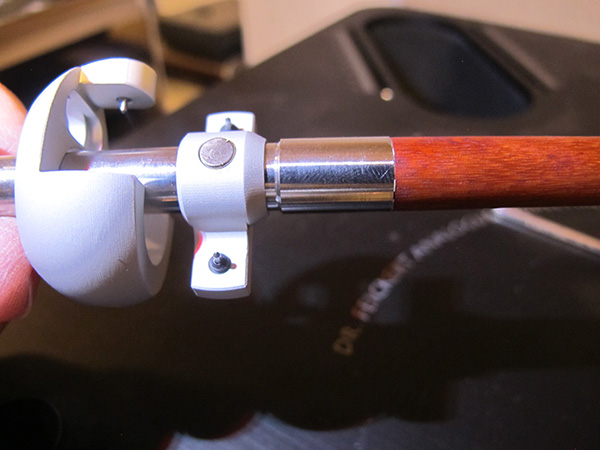
Rotating the Reed's armtube exposes the two vertical-movement bearing points and stabilizing magnet.
The 3P's unique bearing system consists of three pivot points, hence the arm's name. While this is just one point fewer than are used in Kuzma's 4Point arm, the arrangement is altogether different. Here, a winged collar fixed to the armtube carries two of the 3P's finely machined points, one on either side of the armtube. These are the two points on which the arm vertically pivots, and they fit into cups built into a neatly machined open frame, shaped somewhat like an egg that's been sliced lengthwise and stood on end. The topmost part of the frame contains the third point, also downward-facing, by means of which the frame and armtube hang from a portion of the stationary mounting structure: that's the horizontal pivot. An impressive animation of the 3P's mechanical structure is available online (footnote 5).
Horizontal stability is maintained with the mutual attraction of two magnets: one built into the bottom of the egg, the other set into a crosspiece that's part of the arm-mount/VTA adjustment tower.
The antiskating force is set with another magnetic-attraction system: one magnet is fixed at the end of a threaded shaft, and two more are embedded in the movable egg, a set distance from one another. As the arm moves across the record, and the space between the fixed magnet and the first moving magnet increases, the space between the fixed magnet and the second moving magnet decreases, allowing a smooth magnetic handoff.
Setup and Use: Because the 3P's designer, Vidmantas Triukas, made the good choice of having no electrical break from cartridge clips to RCA plugs, care must be exercised in fitting the armtube into its frame, and in hanging the frame on the mounting structure's horizontal bearing platform so that all three points are correctly seated—all while being careful not to stress the wires going from the armtube into the main post.
Probably because of a translation error, the instructions incorrectly labeled the pivot-to-spindle distance as the "mounting distance"—and in an offset design such as the 3P (or the Kuzma 4Point or the TriPlanar), where the tonearm pivot and the tonearm-mounting hole are not concentric, these are not the same thing. Reed has promised to fix this.
I appreciated that the 3P arm can be locked in place with a setscrew. You just have to be careful not to apply too much pressure or you might mar the wood. A frame carrying an underslung counterweight slides easily onto the stub end of the armtube, and locks in place with another setscrew; when the frame is locked in place, the weight can then be screwed in and out to fine-tune the vertical tracking force (VTF).
The VTA and stylus rake angle (SRA) are adjusted with a unique dual system that uses a lockable, threaded post and top-mounted knob to position the armtube parallel to the record surface, and then a side-mounted lever to make finer adjustments while playing a record—after which you lock down the whole thing. If you insist that LPs of different thicknesses require different settings of VTA and SRA for each thickness, the 3P may be for you.
Another knob adjusts azimuth on the fly by moving the horizontal pivot point relative to the two vertical pivot points. If you calibrate azimuth by listening, not measuring, this feature will be useful.
Reed offers no guidance in how to set antiskating. The only test record I ever found that was worth recommending for this was Telarc's Omnidisc, now out of print. Otherwise, you'll have to observe the deflection of the cantilever during play, and adjust the antiskating until the cantilever remains centered, without being pulled one way or the other.
I set up tonearms all the time, and installing the Reed 3P was a total pleasure. Using and listening to it were equally enjoyable. I installed the Lyra Etna and Ortofon A95, and found each cartridge's performance in the 3P free of sonic surprises. The mass/compliance of both pairings put the combination's resonant frequency at around 10Hz, which is ideal.
Footnote 1: See New York Times, January 16, 2016.
Footnote 2: See Music Connection, October 11, 1983.
Footnote 3: Reed, Upes 26, Naujuju Muniskiu k., 54317Kauno raj, Lithuania. Tel: (370) 610 41639. Web: www.reed.lt. US distributor: Axiss Audio, 17800 S. Main Street, Suite 109, Gardena, CA 90248. Tel: (310) 329-0187. Web: www.axissaudio.com
Footnote 4: See www.reed.lt/research/58-wood-vs-the-rest-testing-armtube-material.
Footnote 5: See www.youtube.com/watch?v=_AM28KJizzU.
- Log in or register to post comments
